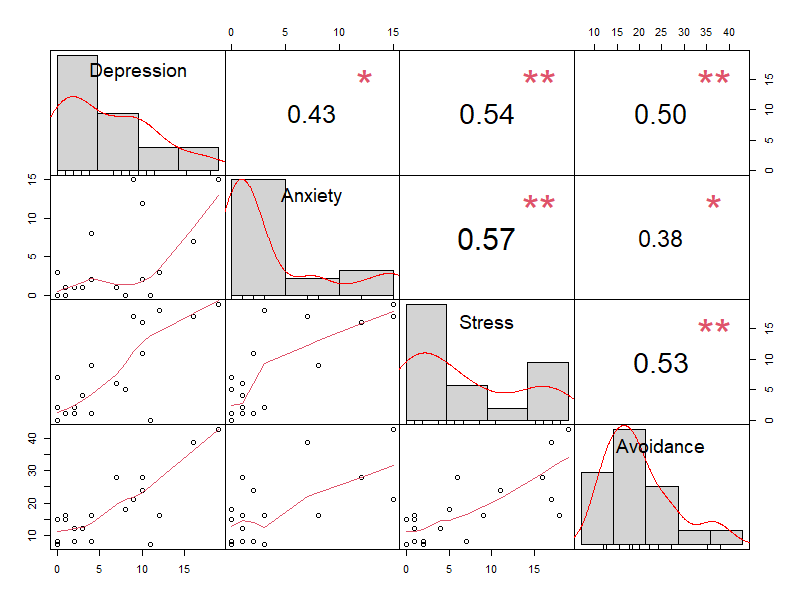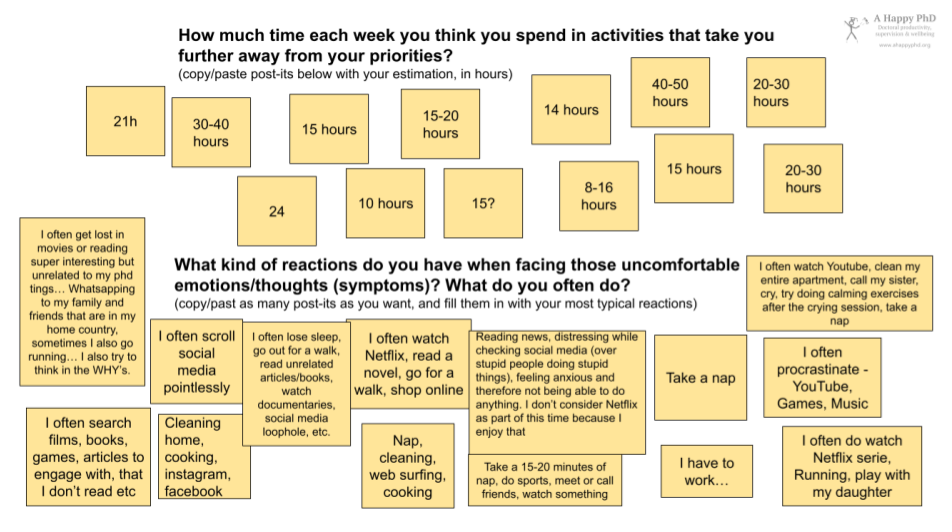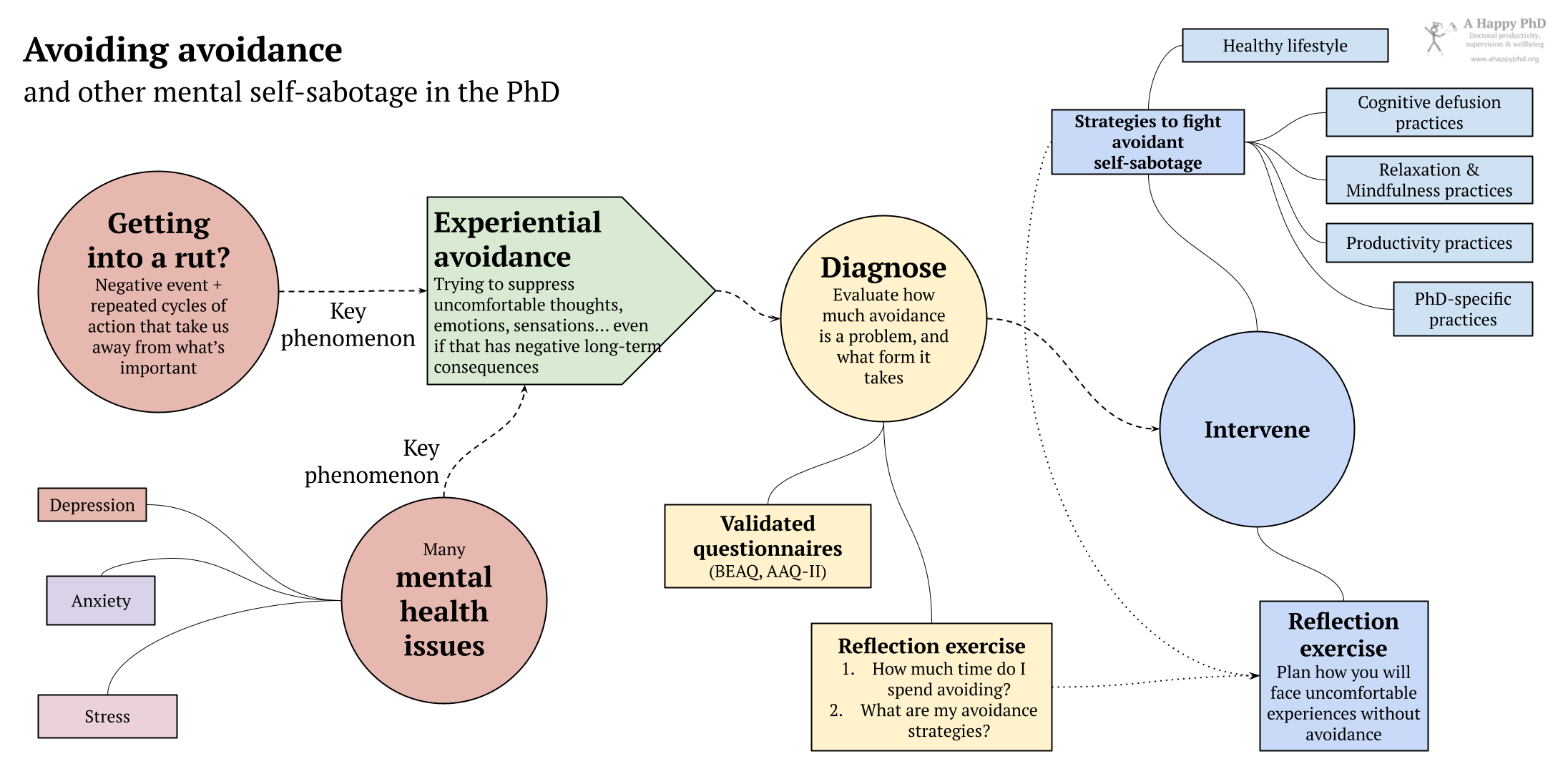POSTS
Avoiding avoidance and other mental self-sabotage in the PhD
by Paula Odriozola-Gonzalez, Luis P. Prieto, - 14 minutes read - 2863 wordsDoes the thesis bring you a sense of anxiety, fear or discomfort? As we saw in a previous post, that is not an uncommon experience at certain points during the PhD. At the heart of many of our unsuccessful strategies to deal with these symptoms (including distraction and addiction) is the notion of avoidance. In this post, we’ll explain what avoidance is, its key role in many mental health afflictions, and suggest exercises and strategies to help us overcome these challenges.
Previously, in A Happy PhD…
In our introduction to mental health in the doctorate, we saw mental-health-related symptoms that many PhD students experience at some point or another during the doctoral journey: thoughts (e.g., “I’m never going to finish this thesis”), emotions (“I am not in the mood for anything”), or physical sensations (“Sometimes I’m short on breath”). We also saw that mental health problems like stress or depression are not something binary, but rather that we all fluctuate up or down their spectrum1 throughout our lives (especially, during the emotionally hard journey of the doctorate, where we get little – and often, negative – feedback). Given the ubiquity of these symptoms, when should we be worried about them? Basically, when they are painful (for us or for others) and incapacitating (they limit our functioning), or we perceive them as recurrent and uncontrollable2. Finally, we saw a couple of simple tips to self-diagnose and start facing these symptoms when (not if) we encounter them during the PhD. Or later on – these issues do not magically disappear when you receive your doctorate! Check the full post if you haven’t read it yet.
Avoidance: A common link in depression, anxiety and stress
See if this kind of cycle sounds familiar: A review comes from one of our submitted papers, with a rejection and a shovelful of negative feedback; this naturally makes us feel bad, and we think that we are not fit for doing a PhD; the following morning, instead of spending the morning writing our next paper as we planned, we postpone it until next Monday, to recover from the blow of the negative review; on Monday, we still feel tired so we tell ourselves that watching a few funny videos will help raise our morale for the writing; half the morning passes by the time we actually sit down to write; it takes us some time to get in the flow of writing so, when the alarm sounds to go for lunch, we have done very little progress on the paper; the thought that we cannot do a PhD thus comes again to our minds; a similar dynamic goes on for several weeks until we realize there is only one week left for the paper deadline, and we scram to write a sub-par paper – which again reinforces our idea that we are not cut for the PhD… or worse yet, we give up altogether and we don’t even scram or submit the paper.
This kind of cycle, which we refer to informally as “getting into a rut”3, is not a peculiarity of yours (or me). Humans have been getting into ruts for millennia: the Buddhist parable of “the second arrow” is precisely about this. The first, negative event is random (and, to a certain extent, unavoidable – we all get rejections and negative feedback sometimes!). As blogger David Cain notes in a nice post about the topic, it is our repeated (and unhelpful) reactions to the pain of this first random arrow which take us deeper and deeper into the ditch, as opposed to trying to get back into the road towards our goals through the shortest path, which would be the logical thing to do.
A key realisation of some modern evidence-based psychotherapeutic approaches is that, at the center of many mental health problems (like depression, chronic anxiety or stress) is this attempt to flee from our negative experiences4 (boredom, rejection, the thought that we are incompetent, etc.): what psychologists call “experiential avoidance”. Mental health problems can be seen as processes with multiple steps, made of thoughts, feelings, and our behaviors in response to them. Coming back to the example cycle above, none of the actions and reactions depicted there are inherently bad. It is when we repeatedly (incontrollably, almost)2 try to suppress these negative experiences at all costs5, that we suffer. We think that, as long as they are present, we cannot progress towards what is important to us (our goals, our values). We thus say NO to living a live we value because we refuse to have these travel companions (e.g., the discomfort of feeling rejected from time to time) come with us.
All this talk about avoidance and mental health issues is nice, but not really specific to doctoral students. Is this really a problem for PhD students, who tend to be a smart and self-driven bunch? We cannot generalize, but below we can see some data from a recent doctoral workshop we run, in which we happened to measure avoidance and several other mental health issues for N=19 doctoral students. The graph shows the correlations between these variables, with asterisks denoting statistical significance of the correlation. Note the strong correlations (for social sciences constructs, at any rate) between avoidance and all the other mental health problems!
If we suspect that such avoidance has become a problem for us, we can take a questionnaire like the Brief Experiential Avoidance Questionnaire6. We could also use the quicker (and widely used in practice) Acceptance and Action Questionnaire II (AAQ-II)7. The good news? Experiential avoidance is not a fixed trait, i.e., we can train ourselves to avoid our negative experiences less (more on that below).
Exercise 1: Our response strategies
To start delving into our avoidance strategies, let’s do a quick reflection exercise. Take a piece of paper (or a couple of post-its) and read again the list of symptoms that we mentioned in the previous post about mental health. Pick those that you experience most frequently (or make up new ones specific to you) and write them on the piece of paper, to focus your attention. Now, take a couple of minutes and answer these two questions below the chosen symptoms:
- How much time each week do I spend trying to avoid these symptoms, or in activities that take me further away from my priorities?
- What kind of reactions do I have when facing those uncomfortable emotions/thoughts (symptoms)? What do I often do?
Write down the answers, but do not judge them (or yourself!) as good or bad yet. For reference, below is a whiteboard with some typical answers by other doctoral students, from a recent workshop where we posed the same two questions. Chances are your responses will be somewhere in the same range:
We are not here to tell you whether your strategies are good or bad. The key is to consider whether they are hampering us from going towards what we think is important. Even a priori good strategies, like self-care, can be overdone if we use them systematically, compulsively to flee away from what we think is important (e.g., getting our doctorate) and the difficult experiences that doing important stuff sometimes brings (e.g., negative feedback about the quality of our work). Context matters!
Strategies against self-sabotage
Now that we have established what things we do that take us away from what is important (and for how long), what do we do about this kind of mental self-sabotage? Here are a few strategies that have worked for many people:
- The basic stuff. We have heard this a million times, but only because it is true. Keeping a healthy lifestyle, sleeping sufficiently, exercising regularly, having a balanced diet… all contribute to our having more energy and self-control, and therefore to better cope with whatever negative experiences the doctorate throws our way. Conversely, lack of sleep is associated with higher levels of mental health issues, compulsive behaviors, etc.8
- Cognitive defusion: This is of the key processes in certain psychotherapeutic approaches. Put simply, this defusion is about separating ourselves from our thoughts, emotions or sensations (e.g., not always believing what we think, because sometimes our thoughts may not be helpful for us to achieve our most important goals). There are multiple ways we can practice this skill9:
- Change our self-talk conventions: Next time we catch ourselves thinking: “I am the worst”, do the following. Change that thought to this seemingly equivalent but quite different one: “I am having the thought that I’m the worst”. This helps us separate from the thought and give us just enough space to think again what is most important for us (doing what we were doing? or believing the thought and doing something else to distract ourselves?) and act in consequence.
- Using repetition to understand that the words in our minds are just that, words. That they are not necessarily the truth. A classic example is thinking about the word “milk” (which probably will conjure very specific images, smells, flavors)… and then repeating the word (“milk, milk, milk, …") until it kinda loses its meaning and we see it as just a series of phonemes. Similarly, next time we think “I’m a failure”, we could repeat it 50+ times (even adding some kind of sing-songy melody), until it does not conjure up the same pang of emotional pain.
- Distancing ourselves from unhelpful thoughts, emotions or sensations: This is a generalization of the previous two strategies – we could even invent our own exercises to reify and distance ourselves from our unhelpful thoughts or feelings. A popular one in our doctoral workshops: the next time we have one such unhelpful thought or emotion (e.g., the ones from the list in a previous post), we can write it down in a post-it (e.g., write down “why does everyone advance faster than I do?"). We then look at the thought written in the post-it without judging it, and thank our mind for conjuring this beautiful thought. Then, we reflect what course of action would be most aligned with our values, we put the post-it in our back pocket (it is a travel companion, even if not a especially helpful one) and we go on with what we decided we want to do.
- Practice, practice, practice: All the techniques above may take some time to sink in (the hardest thing is to actually remember to do them in the moment!). Yet, if we practice them, we will get better at it very soon! We could also use an index card, post-it or some other visible reminder (to carry with us or to put in our workspace), to make these practices our “ongoing mantras”.
- Relaxation and mindfulness: To foster our “remembering to do the practice”, and generally to recognize our experience in the moment as it is happening, without necessarily judging it, we can adopt a regular (formal or informal) mindfulness practice. We can find descriptions (and audio guides) of many such practices in this website, and in mobile apps such as Headspace.
- PhD-specific practices: We have covered in the blog exercises tailored for the difficulties of doctoral work (like the self-interruption we often experience while doing hard cognitive work like scientific writing). For instance, we can practice getting to know this uncomfortableness. Or we can make up our own similar practices!
- Productivity-related advice: Once we have caught ourselves having these uncomfortable thoughts, emotions and cycles of unhelpful action, all we need to do is to focus on doing more of what we think moves us towards important goals in our life (not what our procrastination urges dictate). Productivity techniques we have covered in the blog, like the “Pomodoro technique” or “granny’s rule” are especially fit for the action-oriented part of getting out of the rut.
Exercise 2: Going towards what is important
Now that we have established common uncomfortable experiences in the doctorate, unhelpful patterns of behavior, and alternative strategies to avoid our mental self-sabotage, it is time to put it all together into a plan for going towards what we think is most important in our life. Below, is a reflection exercise we can do, based on existing ACT research10, applied to the domain of our lives where the doctorate is. However, we could also do a similar exercise for other important areas of our life where we have trouble doing what’s important (e.g., family/marriage, citizenship/community, etc.).
The exercise instructions guide us through a diagram like the one shown below. We can do it on pen and paper, or we can just copy this template whiteboard and fill it in (a Google account is needed to create the copy). Basically, we need to answer three questions:
- What are common uncomfortable emotions/sensations I currently face (especially when working on your research tasks)? (see the previous post on mental health for a list of common ones)
- What kinds of actions do I take controlled by those emotions/sensations, which take me away from what I consider important (e.g., finishing my PhD)? (see exercise #1 above). These can become part of an ongoing “not-to-do list”.
- What actions/habits could I take instead to go more in the direction I consider important? (see the strategies against self-sabotage above or come up with your own rules, habits and actions that make sense for your context and current circumstances)
That’s it. Once done, we can keep the filled-in diagram somewhere visible on our workspace, and whenever we feel like falling into one of our unhelpful cycles, we can look at it and implement one of the alternative strategies instead. It is worth saying it again: this may not all work flawlessly at first (we may not notice the rut creeping in, or we may forget about the alternative strategies). But, if we keep making the effort, we will get better at avoiding the self-sabotage of avoidance, and doing more of the important stuff in our life (including the thesis!). This exercise is also part of our Happy PhD Toolkit.
The following diagram summarizes the main ideas of this post:
NB: If the exercise above is still too vague and you would like to try a similar but more structured step-by-step exercise, you could also try this tool (currently in beta) from ClearerThinking.org.
Hope you get better at doing the important stuff.
I am still practicing myself.
What are your favorite unhelpful strategies and rut cycles? Did you try the reflection exercises above? Did they help you? Let us know in the comments section below!
Header image by DALL-Emini: a really cool AI project that generates original images using a text prompt. Try it out!
-
You can find a more complete list of common symptoms associated with mental health problems in the Depression, Anxiety, Stress Scales, see Lovibond, P. F., & Lovibond, S. H. (1995). The structure of negative emotional states: Comparison of the Depression Anxiety Stress Scales (DASS) with the Beck Depression and Anxiety Inventories. Behaviour Research and Therapy, 33(3), 335–343. Official website. ↩︎
-
Ehring, T., Zetsche, U., Weidacker, K., Wahl, K., Schönfeld, S. y Ehlers, A. (2011). The Perseverative Thinking Questionnaire (PTQ): Validation of a content-independent measure of repetitive negative thinking. Journal of Behavior Therapy and Experimental Psychiatry, 42(2), 225-232. ↩︎
-
Ruts are the tracks that the repeated passage of wheels make in a path. If you have ever biked on a formerly muddy path used by tractors and other heavy vehicles, you probably have noticed the property of these usage tracks to “railroad” you if you happen to fall with your bike into one. ↩︎
-
Hayes, S. C., Wilson, K. G., Gifford, E. V., Follette, V. M., & Strosahl, K. (1996). Experiential avoidance and behavioral disorders: A functional dimensional approach to diagnosis and treatment. Journal of Consulting and Clinical Psychology, 64(6), 1152–1168. https://doi.org/10.1037/0022-006X.64.6.1152 ↩︎
-
Wegner, D. M. (1989). White bears and other unwanted thoughts: Suppression, obsession, and the psychology of mental control. Penguin Press. ↩︎
-
Gámez, W., Chmielewski, M., Kotov, R., Ruggero, C., Suzuki, N., & Watson, D. (2014). The Brief Experiential Avoidance Questionnaire: Development and initial validation. Psychological Assessment, 26(1), 35–45. https://doi.org/10.1037/a0034473. The actual questionnaire you can find in the last page of the paper’s full version downloadable here. ↩︎
-
Bond, F. W., Hayes, S. C., Baer, R. A., Carpenter, K. M., Guenole, N., Orcutt, H. K., Waltz, T., & Zettle, R. D. (2011). Preliminary psychometric properties of the Acceptance and Action Questionnaire–II: A revised measure of psychological inflexibility and experiential avoidance. Behavior Therapy, 42(4), 676–688. You can find the actual questionnaire here. ↩︎
-
Walker, M. (2017). Why we sleep: The new science of sleep and dreams. Penguin UK. ↩︎
-
Blackledge, J. T. (2015). Cognitive defusion in practice: A clinician’s guide to assessing, observing, and supporting change in your client. New Harbinger Publications. ↩︎
-
Ruiz, F. J., Hernández, D. R., Falcón, J. C. S., & Luciano, C. (2016). Effect of a one-session ACT protocol in disrupting repetitive negative thinking: A randomized multiple-baseline design. International Journal of Psychology and Psychological Therapy, 16(3), 213–233. ↩︎

Paula Odriozola-González
Paula is an Associate Professor at the Universidad de Cantabria (Spain). As a psychologist and licensed psychotherapist, she is very interested in supporting the emotional well-being of university students and how it relates to their academic performance.

Luis P. Prieto
Luis P. is a Ramón y Cajal research fellow at the University of Valladolid (Spain), investigating learning technologies, especially learning analytics. He is also an avid learner about doctoral education and supervision, and he's the main author at the A Happy PhD blog.



